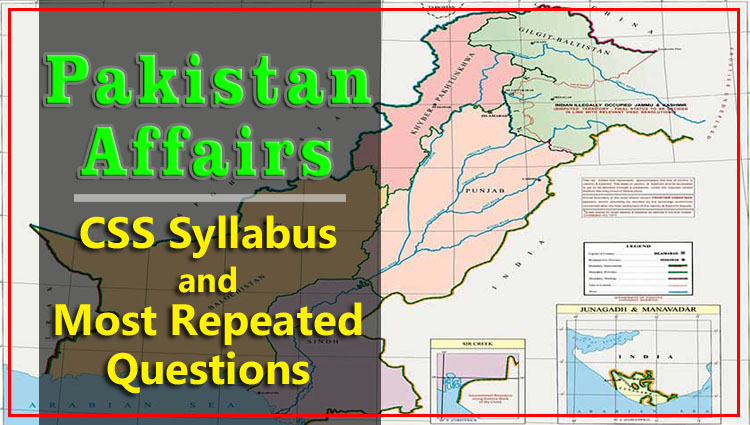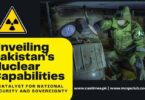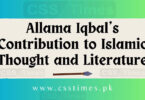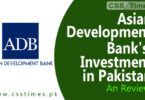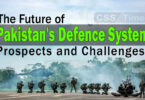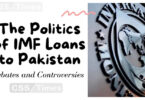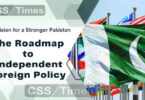I) Ideology of Pakistan
definition and elucidation, historical aspects:
Beside ideology which factors were responsible for the creation of Pakistan? (CSS 1988, 1990)
Causes of Muslim separatism. (CSS 1991, 1996)
Ideological foundations of “Two-Nations Theory“. (CSS 2002, 2003)
Elucidate Ideology of Pakistan. What are the reasons which contributed for the development of two-nation-theory? Is two-nation-theory relevant after the fall of Dacca? (CSS 2007)
Muslims Nationalism in subcontinent evolved gradually. (CSS 1988)
Muslims preserving their faith, culture & separate entity since they set their foot in the sub-continent. ( CSS 1992)
“The Simla Deputation, 1906 laid the foundation for the creation of Pakistan” Substantiate your view point with solid arguments. (CSS 2014)
Evolution of Muslim society in the subcontinent from 1206-1526 A.D. (CSS 2000, 2001, 2002)
Role and efforts of Muslim religious leaders for the establishment of Muslim society in the subcontinent.( CSS 2003,2007)
Separation of East Pakistan, though a tragic part of history of Pakistan, was not the negation of two nation theory“. Comment (CSS 2015)
Highlight the factors which played significant role in the evolution and growth of Muslim Society in Sub Continent? (CSS 2014)
Briefly describe the genuine factors which were responsible for the demand of separate homeland by the Muslims of the Sub Continent (CSS 2014)
Muslim rule in the Sub-Continent, its downfall and efforts for Renaissance.
Downfall of Muslim rule in subcontinent in 18th century. (CSS 1988, 1995, 1999, 2004, 2005)
War of Independence 1857 and its effects. (CSS 1993)
Impact of Muslim rule on social conditions in subcontinent. (CSS 1995)
Describe the most notable feature of Muslims in India in the light of their monothestic religion and egalitarian social structure. (CSS 2006)
Critically analyze the elections of 1937 and the sufferings and grievances of the Muslims under the Congress rule in the provinces (1937-1939). How much did it help in popularizing the idea of a separate Muslim state in India? (CSS 2016)
Khilafat Movement was emotional movement”. Discuss (CSS 2015)
“It was over-reaction of Hindus to the partition of the Bengal in 1905 that widened the gulf between Muslims and Hindus”. Comment (CSS 2015)
Movements for reforms—
Shaikh Ahmad Sarhindi,
Shah Waliullah,
Sayyid Ahmad Shaheed,
Aligarh,
Deoband,
Nadwah, and other educational institutions——-
Sindh Madrassah and Islamia College Peshawar.
The Aligarh Movement was a pure educational venture but it had deep impacts on Indian politics. Discuss.(CSS 2016)
Shahwalliullah’s efforts for the revival of Muslim rule in India. (CSS 1989, 1994, 1997, 1999, 2001 , 2016)
Impact of the movements of reform__ Shaikh Ahmad Sirhindi, Shahwlliullah, Aligarh, Deoband, Nadwa __ on muslims of subcontinent. (CSS 1991 ,1994 ,2009)
Ulemas of Nadwa attempted to make a synthesis of Westernism /Modernism of Aligarh and Conservation of Deoband. (CSS 1998,2002)
Aligarh Movement brought about a renaissance amongst the Indian Muslims. (CSS 1995, 1999, 2004, 2008)
Political objectives of Aligarh Movement. (CSS 2001)
Khilafat Movement. (CSS 1989, 1996, 2004)
Contribution of fraizi movement in the life of Muslims in the sub-continent. (CSS 2005)
The Deoband School stood for “definite religio- political goals with limited sphere of influence.(CSS 2007)
Influence of Sheikh Ahmad Sirhindi has left on the history of Muslims of India. (CSS 2008)
Sir Syed Ahmed Khan’s endeavors to make Muslims psychologically adjusted to the new environment. (CSS 1990,1992)
Steps initiated by Sir Syed Ahmed Khan which later on became the agenda points of the movement for Pakistan? (CSS 2009)
Contribution of Sir Syed Ahmed Khan towards the growth of Muslim Nationalism. (CSS 1989)
Sir Syed Ahmed Khan had forseen two nations, Muslims & Hindus. (CSS 1993)
Why Sir Syed advanced to the Indian Muslims to eschew politics. (CSS 2002)
“Sir Syed Ahmad Khan was in no way pro-British.” Agree or disagree, answer with arguments. (CSS 2015)
Evaluate the impact of the services rendered by Sir Syed Ahmad Khan towards the regeneration of the Muslims? (CSS 2014)
Ideology of Pakistan in the light of Speeches and statements of Allama Iqbal and Quaid- i Azam Muhammad Ali Jinnah.
Jinnah in his Presidential Address to the annual session of All India Muslim League in March 1940 said. “The problem in India is not of an inter-communal character, but manifestly of an international one, and it must be treated as such.” Write note on the Two Nation Theory and the Lahore Resolution of March 1940 in the light of this statement. (CSS 2016)
Evaluate Quaid-e-Azam’s 14 points. (CSS 1996, 1997)
Compare & contrast the Nehru report & Quaid-e-Azam’s 14 points. (CSS 1996, 2001)
Importance of Quaid e Azam’s leadership in achieving a separate homeland OR achievements of Quaid. (CSS 1998, 1999)
Assess the account for the problems which Quaid-e-Azam had to face as Governor General of Pakistan. (CSS 2006)
What type of political system the Quaid had visualised for Pakistan. (CSS 1990)
Political sagacity of Quaid-e-Azam. (CSS 1991)
Constitutionalism, elementary part of Quaid-e-Azam’s political character. (CSS 1992)
Illustrate the role of Quaid-e-Azam for protecting the constitutional rights of Muslims of the subcontinent from 1916-1933? (CSS 2009)
II) Land and people of Pakistan
Geography, Society, Natural resources, Agriculture, Industry and education with reference to characteristics, trends and problems.
Enumerate the measures adopted by HEC for promotion of higher education and qualitative research in Pakistan. (CSS 2017)
- Short Note: Geo-Political position of Pakistan. (CSS 2003)
- Define and explain the geographic inertia and its role in the development of Pakistan (CSS 2005)
- Political map of Pakistan is the outcome of its geo-strategic location. Give a reasoned account for the statement. (CSS 2006)
Political map of Pakistan is the outcome of its geo-strategic location. Give a reasoned account for the statement. (CSS 2006)
Geographical features & natural resources of Pakistan. (CSS 1993)
Impact of Pakistan’s geography on its socio-economic patterns. (CSS 1996)
Use of natural resources, agriculture, industrial manpower, and export & import to turn Pakistan in a rich country. (CSS 1988)
Main sources of energy in Pakistan. Their use in development. (CSS 1990, 1997)
Main obstacles in the way of developing our energy resources. Solutions? (CSS 1992)
What do you know about water crisis in Pakistan solution? (CSS 2004)
Indus Water treaty. (CSS 1997)
The development of water resources in the Indus Basin. (CSS 2005)
The government measures to improve the agricultural productivity in the light of introducing new irrigation projects. (CSS 2006)
In spite of strong research base, rich lands, reasonable water resources and various land reforms why agriculture remained less developed in Pakistan? (CSS 2009)
Account for the initial concentration of agro based industry in the manufacturing belt of Pakistan.(CSS 2005)
What are the problems of industrialization in Pakistan? (CSS 2002, 2008)
Describe the distribution of Iron and Steel industry of Pakistan. Evaluate its role in the industrial development of the country. (CSS 2006)
Pakistan can become one of the richest countries of the world, if we make best use of our natural resources.” Elaborate in the light of present situation of the Country (CSS 2014)
“Population explosion in Pakistan is emerging as the greatest threat to the economy of Pakistan”. Comment (CSS 2014)
The location of Pakistan has given the strategic strength to the State. What are its physical features and narrate its advantages and dis-advantages (CSS 2012)
III) Pakistan and Changing Regional Apparatus
IV) Nuclear Program of Pakistan, its Safety and Security; International Concerns
V) Regional Cooperation Organizations (SAARC,ECO,SCO) and the Role of Pakistan
Explore the significance of Shanghai Cooperation Organization (SCO) for Pakistan. (CSS 2017)
VI) Civil-Military Relations in Pakistan
VII) Economic Challenges in Pakistan
VIII) Non-Traditional Security Threats in Pakistan: Role of Non-State Actors
Write note on the Afghan War since 1979 and its impacts on Pakistan. How far the emergence of the “Non-State Actors” and Non-Traditional Security Threats in Pakistan can be attributed to the decades-long warfare in Afghanistan? (CSS 2016)
IX) Pakistan’s Role in the Region
CPEC is a flagship project of One Belt One Road (OBOR) and a regional game changer. Explain. (CSS 2017)
X) The Palestine Issue
XI) Changing Security Dynamics for Pakistan: Challenges to National Security of Pakistan
XII) Political Evolution Since 1971
XIII) Pakistan and US War on Terror
Pakistan’s role in the war against terrorism. (CSS 2004,2009 , 2015)
XIV) Foreign Policy of Pakistan Post 9/11
Write note on the post 9/11 foreign policy of Pakistan. What role do you foresee for Pakistan in regional and global politics in the near future? (CSS 2016)
XV) Evolution of Democratic System in Pakistan
How general elections in 2002, 2008 and 2013 strengthened democracy in Pakistan. (CSS-2017)
XVI) Ethnic Issues and National Integration
Pakistan’s national culture reflects unity in diversity. Elaborate. (CSS 2017)
Was Islamization during Zia Era a need of the time, or was it Political propaganda? (CSS 2015)
Briefly discuss the main features of the cultural heritage of Pakistan. (CSS-2015)
XVII) Hydro Politics; Water Issues in Domestic and Regional Context
“The twentieth century witnessed the war for oil. The twenty-first century will witness the war for water”. Examine the practical implications of this statement on situation of Pakistan. (CSS 2013)
What do you know about Water Crisis in Pakistan? Also suggest concrete steps for its solution. (CSS 2004)
Using as much evidence as possible, outline a case for the development of water resources in the Indus Basin. Examine also polity in this phenomenon. (CSS 2005)
“The twentieth century witnessed the war for oil. The twenty-first century will witness the war for water”. Examine the practical implications of this statement on situation of Pakistan. (CSS 2013)
XVIII) Pakistan’s National Interest
XIX) Challenges to Sovereignty
XX) Pakistan’s Energy Problems and their Effects
Explore the option of alternative energy resource to overcome energy crisis in Pakistan. (CSS 2017)
XXI) Pakistan’s Relations with Neighbors excluding India
XXII) Pakistan and India Relations Since 1947
XXIII) The Kashmir Issue
Discuss the Kashmir problem in its entirety; throwing light on its background and prospects of possible solutions to this core issue between India and Pakistan. (CSS 2016)
Short Note: Kashmir conflict. (CSS 2001)
The Indian Policy on Kashmir is caught on the horns of a dilemma and that dilemma is that if it accepts the verdict of the people, it has to vacate the territory of state of Junagarh, Manavadhar, Mangrol, Hyderabad etc. Explain. (CSS 2002)
The so-called ‘Instrument of Accession’ of Bharat with Kashmir “is fraudulent and impossible to accept” as it is “based on violence”. In the light of the Quaid-e-Azams statement makes a comparison and correlation of the Slate of Jammu and Kashmir with the State of Junagadh, Manavadhar, Mangrol, Sardargarh, Bantva and Hyderabad etc. (CSS 2003)
XXIV) The war in Afghanistan since 1979 and its impact on, and challenges to Pakistan in the Post 2014 era.
XXV) Proxy Wars: Role of External Elements
XXVI) Economic Conditions of Pakistan, the Most Recent Economic Survey, the Previous and Current Budgets, and the Problems and Performance of Major Sectors of Economy.
XXVII) The Recent Constitutional and Legal Debates, the Latest Constitutional Amendments and Important Legislations, Legal Cases and the Role of Higher Courts.
Discuss the role of judiciary in the constitutional development of Pakistan. (CSS 2017)
Give a critical appraisal of the constitutional crisis during the period of Governor General Ghulam Mohammad. Write its effects on the subsequent history of Pakistan. (CSS 2000)
Short Note: The salient features of the Constitution of 1956. (CSS 2000)
The Constitution of Pakistan (1973) is the “mouth piece of Islam”. Discuss. (CSS 2008)
Illustrate the role of Quaid-e-Azam for protecting the constitutional rights of Muslims of the subcontinent from 1916-1933? (CSS 2009)
Give a critical appraisal of the constitutional crises/crises initiated by the controversial actions taken by Governor General Ghulam Muhammad and endorsed by the superior Court of Pakistan. Discuss and analyze its effects on the subsequent history of Pakistan. (CSS 2011)
Federalism has been a continuing cause of political tension in our country. Will the 18th amendment made in the constitution by the present Government solve this issue for all? Take a position and support with your argument. (CSS 2011)
XXVIII) The Prevailing Social Problems of Pakistan and the Strategies to Deal with Them, Poverty, Education, Health and Sanitation.
Unemployment in Pakistan. (CSS 2000)
Corruption in Pakistan. (CSS 2000)
Population growth as a factor conditioning our social & economic development /Effects of population growth. (CSS 1992 ,2001)
Low literacy rates in Pakistan. (CSS 1995,1999)
Implications of privatized education in Pakistan. (CSS 1996)
Critically examine Education system of Pakistan. (CSS 1999)
Problems of Educational System in Pakistan. (CSS 2003)
Before you leave check our complete range of Pakistan Affairs Notes
- Four reasons why Pakistan and India should make peace now
- Indo-Pak Water Vows: Implications and Way Forward
- Shaikh Ahmad Sirhindi & His Impacts On Muslims’ Society And Politics On The Indian Sub-Continent.
- List of Founders and activists of the Pakistan Movement
- Pakistan’s National Cyber Security Policy 2021 (PDF)
- Current Affairs Cloud for CSS /PMS Exams (May 25, 2021)
- Current Affairs Cloud for CSS Exams (May 20, 2021)
- “Separation of East Pakistan, though a tragic part of History of Pakistan, was not the negation of two nation theory”. (CSS Pakistan Affairs Paper 2015)
- Pakistan’s Educational Problems | Pakistan Affairs Notes
- Pakistan Affairs | CSS Syllabus and Most Repeated Questions

